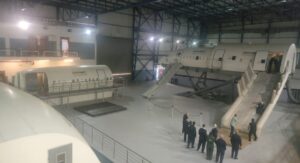
By :Mohamed Attia
Minister of Civil Aviation Mohamed Manar paid a 3-hour tour to workshops for mechanical units, the new daily maintenance building, the technical warehouse complex at EgyptAir Maintenance and Engineering Company and the EgyptAir Training Academy.
The tour began with the mechanical units workshop during which President of EgyptAir Maintenance and Engineering Company Hani Salah El-Din reviewed the capabilities of the company, which is the only one in the field of providing integrated services for maintenance, repair and reconstruction of aircraft, engines and aircraft parts in Egypt and one of the leading companies in this field in the Middle East and Africa region.

Salah El-Din added that the company provides maintenance, repair and reconstruction services for a large number of aircraft models, ranging from large models (Airbus A340, A330 and Boeing B777) and medium models (Airbus A320/A321 and Boeing B737), through to cargo planes (Airbus A300B4, A600F and A330F).
He pointed out that the company had recently added maintenance and repair capabilities to the Boeing B787 and Airbus A220 models.
He pointed out that the company owns 3 aircraft maintenance hangars and work is underway to establish a fourth hangar to accommodate the increase in the number of EgyptAir planes and customer planes, and maintenance workshops for aircraft parts and units.
Salah El-Din, chairman of EgyptAir Maintenance and Engineering Company, said that the number of employees in the company is about 4768 people from various disciplines working 24 hours inside and outside Egypt through the main maintenance base at Cairo International Airport, 8 stations at Egyptian airports, and 13 external stations to serve more than 140 customers from airlines in the Middle East, Africa, Europe and Asia.

He added that the company is keen to provide the best technical service to its customers and to emphasize the quality element as one of the most important elements of attracting customers.
He said that the company succeeded in obtaining the accreditation of the European Aviation Safety Agency (EASA) in 2006 and the US Federal Aviation Administration in 2009.
Meanwhile, a review is conducted by both parties to renew them twice annually, and they are the two largest bodies in the world in accrediting aircraft maintenance companies.

Salah El-Din pointed out that after that, many of the civil aviation authorities’ approvals will come in different countries in the Middle East, at the African, Arab and European levels.
He pointed out that it reflects the efficiency of the technical staff, including engineers and technicians, in carrying out the tasks entrusted to them, and the reviews are carried out with the utmost accuracy and the most accurate details of the work to ensure the quality and validity of the equipment and the full comprehension of the personnel of international legislation and their technical role.
After that, Minister Manar accompanied the aviation editors on an inspection tour of the EgyptAir Training Academy. They were received by Ihab El-Tahtawy, head of the EgyptAir Training Academy, who confirmed that the academy was able to pass many accreditations, including the accreditation of the International Aviation Safety Assessment (IASA) and the accreditation of the International Civil Aviation Organization (ICAO).

He added that the academy spent $125 million during the last period to upgrade the level of training, $25 million of which were spent during 2019 only on purchasing analog flight equipment, qualifying trainees and expanding the construction of new buildings. He noted that the academy has 6 analog flight devices and 64 classrooms equipped at the highest level for all training activities. He also said that the academy trains all workers dealing with passengers, starting from buying the ticket, entering the airport, and even receiving bags.

For his part, Wael Farag, the director of the academy’s website, reviewed the stages of the academy’s development since it was a sector in the Ministry of Civil Aviation until it was transformed into a center in 2002 and then became an academy in 2017 that includes more than one training department with a total area of 70,000 square meters and offers 72 1,000 training hours annually.







Discussion about this post